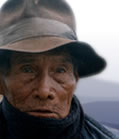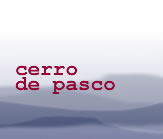Magno is originally from the Saco community in La Oroya. He is a community leader and earns a living from construction work. Magno talks about the changes in his community: how it was once a agriculture and dairy producing region and how this all changed following the installation of a smelter.
He speaks about his childhood and how he realised that making a living from livestock was not profitable. He got involved in construction work. He also talks about the how local people dealt with the fact that they could no longer live from the land.
Magno also points out the health hazards related to the development of mining in the region. He describes his involvement in SAIS, the Sociedad Agricola de Interes Social, and the disputes in which the community was involved, in order to gain compensation for the damage caused by the fumes. He also speaks about the effects pollution has had on the animals, on land and in rivers.
Magno refers to local customs, celebrations and sports and the alternative routes the community should pursue in order to achieve some sort of development. He believes that, “we need to organise ourselves [the community] as a company so that we can have support from public and financial entities.” Magno also talks about his children, education and population growth.
|
You will need a password from Panos to view the full
transcript of the interview. To apply for a password, click here.
Once you have a password, click here to go to the beginning
of the transcript. You can also click on any section of the
breakdown of content below and go straight to the
corresponding part of the transcript.
|
| Section 1 |
Explains that prior to the installation of the smelter in Cerro de Pasco, his community, Santa Rosa de Saco, was an agricultural community. Pollution from the smelter has damaged the vegetation and animals.
|
| Section 2 |
Changes in Saco: dairy industry disappeared; fumes from the smelter ruined the prospects of raising animals and cultivating. Residents are forced to migrate or work for the Cerro de Pasco Corporation
His father worked for the railroad company
|
| Section 3 |
His mother was involved in cattle ranching; both are from Saco
Magno helped with sheep when he was young but did not continue as an adult because working with livestock was not profitable
Dry land, not enough grass, sheep don’t produce milk and lambs die.
Water problem: company takes the farmers' water
|
| Section 4 |
Magno leaves the shepherd’s life for construction work in Lima and Huancayo.
People no longer rely on ranching because it isn't profitable. Poverty of the campesinos. Lack of grazing land is due to the fumes from the smelter
|
| Section 5 |
More about the damage caused by pollution. Decline of livestock leads community members to work independently or for the mining companies. Independent work includes construction and informal vending. Residents also migrate to other parts of Peru or abroad.
|
| Section 6 |
His brother and uncle both died from cancer. Talks about other illnesses related to pollution. Talks about his role as a community leader
|
| Section 7 |
SAIS (Agricultural Society of Social Interest) unites the communities of the area.
Currently their main activity is developing livestock production in the area.
Talks about his role as President of SAIS and the negotiations carried out to receive compensation for the damage created by the company. Compensation is awarded after a long time because of slow legal system that traditionally favours large companies
|
| Section 8 |
Compensation was according to the degree of damage; but the amount was very little. The money awarded for compensation was invested in a communal farm which no longer exists, so he concludes that compensation has been useless.
|
| Section 9 |
The frost and the fumes both affect grazing land
Llamas are more resistant to fumes and to small amounts of grazing land Donkeys are susceptible to fumes, although they do resist the altitude
Poultry and guinea pigs have adapted well; however, since the altitude affects them they must be sold or eaten when they are older
|
| Section 10 |
The experience with fish farming has been positive and should expand
Contamination of rivers as a result of miners: trout has disappeared. Concentrators not the mining per se have contaminated the rivers
|
| Section 11 |
Talks about different leadership positions he has held
Football and other sports
|
| Section 12 |
Fiestas (festivals, celebrations) – main one in Saco is Santa Rosa Day
Community members are firm believers in their patron saints, are not "petty" about celebrating them
Explains role of Mayordomo (master of ceremonies): a different person is elected each year for this role.
|
| Section 13 |
The fiesta has changed little over time but has become bigger due to a larger population. Richer community members almost compete during the celebration by trying to bring the best bands etc. Explains that previously the fiesta included sports competitions but not any more
|
| Section 14 |
Carnival is celebrated like in the rest of the central region. Talks about other celebrations. Alcohol plays a role in the festivities - beer and local cane drink.
Aside from cultural and religious festivals they also celebrate the transformation of Saco from a community to a district
|
| Section 15 |
Extent of these celebrations depends on finances and who is in charge of the local government
Weddings in Saco and palpay weddings. Changes in celebrations: palomay– locking bride and groom up whilst guests continue to celebrate – is no longer practised. |
| Section 16 |
Talks about formalising his relationship with his wife - family acceptance is more important than the actual act of getting married. People choose different ways of getting together with their partners
Talks about the needs of the community and the creating a “communal company”; emphasis is on improving production and increasing cooperation among residents.
He has three children.
|
| Section 17 |
The boys are also builders, although they have their own aspirations. Believes there is a need for more work opportunities and technical schools because Sacos is no longer an agricultural or livestock community
The population has increased – immigrants from the areas affected by terrorism.
Newcomers are unaware of the risks involved in investing in cultivation in the area: fumes and frost together ruin the crops
|


